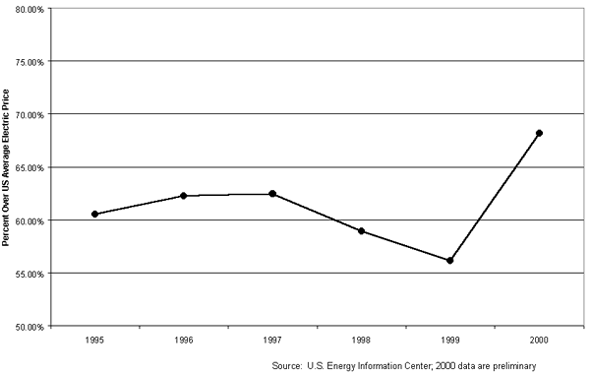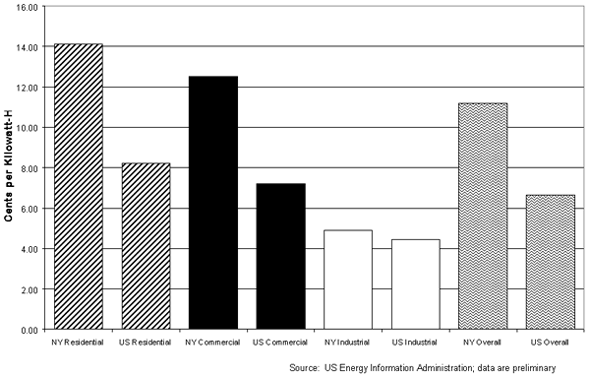|
I. Consumer Rate Relief
A. Universal Service Rate
The Emergency Ratepayer Protection Act includes a universal service rate, which provides a 25 percent
per month rate cut for the first 200 kwh used by residential customers. Because 200 kwh represents the
amount of energy needed to maintain the basic necessities of a small household, this Universal Service
Rate will provide energy security and affordability to the customers who most need it, including seniors
living on fixed incomes, while providing substantial rate relief to all residential customers.
B. Elimination of the Gross Receipts Tax
The Gross Receipts Tax (GRT) on electricity and natural gas charged to utility companies is passed
directly on to consumers. The State Fiscal Year (SFY) 2000-2001 Budget included a partial elimination of
the GRT. The Assembly Majority Budget Resolution for SFY 2001-02 includes a phased reduction that
completes the elimination of this tax. This action will save taxpayers over $350 million annually when
fully implemented, and will help ease the energy cost burden on residential customers.
C. Energy Consumer Protection Act
Under the PSC's deregulation scheme for the natural gas and electric industries, energy consumers who
choose alternative suppliers, called Energy Service Companies (ESCOs), do not receive the same rights
and legal protection as do people who stay with their incumbent utility. The Energy Consumer Protection
Act would extend the legal protections incorporated within the Home Energy Fair Practices Act to all
residential energy consumers and would guard against any unreasonable demands, conditions, and burdens
placed on them by an ESCO.
This bill would also require ESCOs to post security with the PSC to protect consumers from bankruptcy,
default or other failure. Furthermore, the bill would also prohibit "slamming", the
unscrupulous practice of switching customers from one service provider to another.
D. Energy Assistance Programs
Since the current Administration began its efforts to deregulate the energy industry, New York's
residential electric energy prices have risen to 82 percent above the national average. Even with the
recent rate increases in California, most New Yorkers still pay higher prices. NYSTEP includes two new
programs to help residential customers pay their eye-popping energy bills.
The first component is a State program to supplement the Federal Home Energy Assistance Program (HEAP),
which provides assistance to low-income residential customers during the winter season. However, the new
State emergency supplemental HEAP program goes further than the federal program in that it also provides
financial assistance for the summer cooling months.
The second component, the Emergency Energy Assistance to Seniors Program extends benefits to seniors who
do not qualify for HEAP but meet the eligibility guidelines for the Elderly Pharmaceutical Insurance
Coverage (EPIC) Program. This benefit would be the same as that under the State emergency supplemental
HEAP program. This program will help these individuals and families pay their skyrocketing energy bills.
E. $1.5 Billion In Funding for Efficiency, Conservation, and Alternative Energy Sources
The Energy Conservation and Investment Act will provide $300 million annually for five years in excess
funds from the Power Authority of the State of New York (PASNY) and the Long Island Power Authority (LIPA)
to provide grants, low-income income loans, and loan guarantees to energy consumers for energy
conservation and efficiency projects. These projects include furnace and boiler replacement, insulation,
appliance purchase rebates, and other weatherization and load management improvements, which will result
in greater energy efficiency and lower energy bills. These funds will also be available for alternative
energy source development and installation, including solar, wind, and fuel cell equipment.
|
May 18, 2001
"Retail competition in New York is not working particularly well right now."
- Phil VanHorne, Vice-President and Operating Manager
Niagara Mohawk Energy Marketing
|
II. Ratepayer Protection
A. Transition Period to Protect Consumers from Energy Price Increases
The Emergency Ratepayer Protection Act places in law a three-year transition period for energy
deregulation. The Pataki Administration's deregulation plan has not resulted in competition in the
electric industry at the wholesale or the retail level, and the Administration has done nothing to protect
customers from dramatic price increases that result from this failed deregulation.
The bill directs the PSC to require electric and gas utilities to take every step necessary to avoid price
increases, including long-term purchase agreements, hedging, and voluntary load reduction. In effect,
the utility must act as a purchasing agent for its customers to obtain the best deal for them. The PSC
will oversee this process by reviewing each utility's plan.
B. Limitation on Automatic Energy Cost Pass-through to Consumers
The sudden price increases experienced last year in New York City led many to question the operation of
the State's electricity markets and whether price gouging had occurred. The price spikes also
demonstrated the need for consumers to have protection from markets where energy prices often were not
known until weeks later when bills were received.
NYSTEP eliminates automatic price pass-throughs to consumers by requiring a review by the Public Service
Commission to ensure that any costs beyond those that are already established in the rates would be passed
along only if they are proven by the utility companies to be absolutely necessary, just, and reasonable.
Utilities would be protected by the requirement that there be a rapid review by the PSC of potentially
excessive costs to determine whether a pass-through is justified as well as a review as to whether prices
obtained by generators are unfair. The PSC would use its regulatory powers to encourage fair pricing
practices by generators.
C. Energy Supply Reliability
Last fall, after sudden price spikes during a relatively cool summer, the PSC suddenly declared an
emergency situation in New York City proclaiming that, without immediate new capacity being brought
on-line, blackouts were likely for the summer of 2001. It is important for the State to avoid future
"surprises" of this sort that appear to create a choice between blackouts and the health and
vitality of local neighborhoods.
NYSTEP addresses the reliability of the electric energy system by ensuring adequate monitoring of the
system and by implementing a planning strategy to insure that the necessary investments in transmission,
distribution, and generation are being made. It also includes requirements for the creation of energy
solutions, including necessary upgrades, to address New York City and Long Island load pockets, and
requires planning to maximize renewable technologies and other resources in New York.
III. Job Growth
|
April 17, 2001
"Rather than becoming more competitive, New York is falling behind other regions of the
country in terms of retaining and attracting jobs."
- Multiple Intervenors Testimony Before the ISO Board
|
A. Expansion of Power for Jobs
Projections indicate that scheduled upgrades at the Niagara and St. Lawrence hydro projects operated by
the Power Authority result in 400 MW of additional generating capacity. Rather than allow them to feed
this capacity into the wholesale energy market to reap windfall revenues, the Assembly plan directs these
400 MW to benefit the State's businesses that create and retain jobs. This new power would be available
for a new regionalized version of the Assembly's successful Power for Jobs program, directed toward Empire
Zones, and areas around the Niagara and St. Lawrence hydroelectric projects.
In the four years since this Assembly initiative was enacted, the Power for Jobs Program has created or
secured over 300,000 jobs across the State. This additional allocation will provide more economic
stimulus to those areas of the State with the greatest need.
B. NYS Energy Research Institute
The Assembly Majority Budget Resolution for SFY 2001-02 creates the New York State Energy Research
Institute to assist advanced energy technology companies to bring their technologies to the market. This
Institute will provide numerous benefits. By spurring the development of new energy technology companies
and assisting them in bringing their products and services to market, it will create new energy industry
jobs. In turn, the products and services of these companies will assist other businesses in cutting their
energy costs and staying competitive.
IV. Environmental Protections
A. Clean Energy Generation Incentive
In some areas with tight electricity supplies and poor air quality, both can be improved through
repowering existing generating facilities. NYSTEP creates an incentive to bring these plants on-line by
accelerating the siting process under Article X of the Public Service Law.. Specifically, the Siting Board
approval time for the repowering of an existing facility, or the phase out of an old facility for a new,
cleaner one is cut in half, from one year to six months. The legislation requires that the repowering
must result in a reduction of at least 75 percent in the rate of emissions for three key pollutants -
nitrogen oxide, sulfur oxide, and particulate matter. This action will encourage and facilitate the
replacement of old, dirty, inefficient plants with modern, cleaner, high efficiency plants. Repowering
or replacing older plants has been proven to increase generating capacity by up to 90 percent and to
result in decreased rate of emissions.
B. High Efficiency Vehicle Incentives
To encourage New Yorkers to purchase vehicles that will help save on fuel costs and protect the
environment, NYSTEP includes the elimination of the state share of the sales tax on highly fuel efficient
vehicles and extremely low emitting vehicles. These vehicles include those meeting super-ultra-low
(SULEV) standards and are 50 percent more fuel-efficient than average cars in the same class.
V. State Agency Reforms
A. Power Authority of the State of New York (PASNY) Reform
The Power Authority generates about 25 percent of the electricity used in New York State at ten generating
facilities and operates 1,400 circuit-miles of transmission lines statewide. Under NYSTEP, a commission
is created to develop a plan to refocus PASNY to better serve the residents of New York State. The
commission is charged with making recommendations on the future role, structure, and governance of PASNY.
As an immediate control measure, PASNY would be made accountable by being made subject to the review of
the Public Authorities Control Board.
B. PSC Reform
The PSC, in conjunction with the current Administration, has taken numerous actions in the name of
competition that has treated consumers unfairly, and have required consumers to bear a disproportionate
share of the burden of the Administration's deregulation failures. The Administration and the PSC have
attempted to implement competition behind closed doors, shutting out customers.
To ensure greater responsiveness to consumer needs, the Assembly Majority's NYSTEP requires that the PSC
Commissioners be elected, and terminates the current practice by which the Governor continues to appoint
its Commissioners without any public accountability or input.
C. Agency Energy Conservation Action Plan
NYSTEP includes legislation that requires the Office of General Services (OGS), in coordination with the
Energy Research and Development Authority (NYSERDA) and the PSC, to prepare an integrated State agency
energy conservation action plan specifying measures to be taken by all State departments and agencies;
the Executive, Legislature, and Judiciary. This will result in the elimination of any wasteful,
inefficient, or non-essential use of energy or energy resources. Conservation goals include a target of
10 percent savings by 2003 and 25 percent by 2010.
NYSTEP also includes a component to foster and facilitate the use of a Statewide Coordinated Carpooling
Plan at all agencies and requires the State fleet to achieve a savings goal of 25 percent by the use of
high mileage or alternative fuel vehicles. PASNY would be required to provide technical and other
assistance to State agencies in order to reduce their energy consumption and waste, and maximize
efficiencies.
|
April 22, 2001
"I think this whole thing about deregulation and retail competition is going to take some
time. This is not something that gets done overnight and it's going to be a much longer transition
than anybody expected."
- Wes von Schack, Chairman, President and CEO
Energy East
|
|


